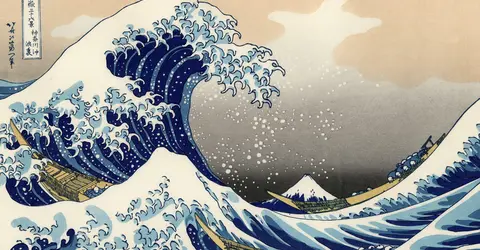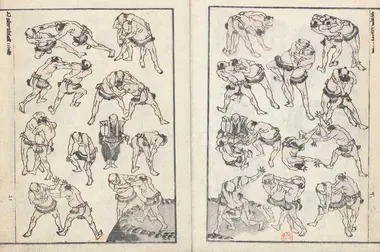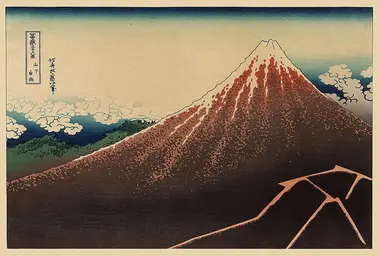Hokusai, master of the print 北斎
- Published on : 26/04/2019
- by : J.R.
- Youtube

The Great Wave off Kanagawa, one of "Thirty-six Views of Mount Fuji", by Japanese painter Katsushika Hokusai
Wikicommons
The master of Japanese prints
Katsushika Hokusai, born in 1760 and died in 1849, is a major artist in the history of Japanese art. His prints are famous throughout the world and he is thus an essential cultural figure in Japan.
The essential master of the print
Hokusai, whose birth name is Tokitaro, was born in Edo, Tokyo's former name, in the Warigesui district on the east bank of the Sumida River. He then set up his workshop there and spent a large part of his life there. This is where the Sumida Hokusai Museum is now dedicated to him, and where visitors can admire his finest works.
He showed an early interest and aptitude for drawing, and thus entered an apprenticeship at the age of 13 in a xylography workshop. At 18, he joined the studio of Katsukawa Shunsho, a famous ukiyo-e painter at the time, who trained him in the delicate art of printmaking. He left the workshop in 1792 on the death of the master and then studied different techniques, going from school to school. In particular, he discovered Western art and perspective. He took the name of Hokusai around 1799 and illustrated many collections of poems.
He began to travel the country from 1812, joining Edo from Kyoto, passing through Nagoya. A collection of his sketchbooks would be published two years later, under the name Manga, which thus marks the invention of this term still used today.
Hokusai finally experienced international recognition from 1831, thanks to the publication of his major work, the series of prints "Thirty-six Views of Mount Fuji". He suffered the great famine of 1836 in Edo, then saw his workshop ravaged by flames in 1839, destroying many of his recent works. During the last ten years of his life, he continued to draw every morning.
On his deathbed, this eternally dissatisfied pronounces these last words: " If the sky had granted me another ten years of life, or even five, I could have become a real painter".
Hokusai and ukiyo-e
Hokusai was both a painter and a draftsman. Ukiyo-e is not a technique but a movement, which integrates both paintings and above all printmaking.
This term meaning " image of the floating world ", transcribes the favorite subjects of ukiyo-e: ephemeral scenes of the living world, but also everyday life.
This term illustrates both the notion of Buddhist impermanence, as well as the carelessness of a changing society.
Ukiyo-e prints are produced from a design, called shita-e. The latter is glued to a wooden board and the white areas are hollowed out: in this process, the original drawing is thus partially destroyed. The engraved plate is then inked and can produce perfect copies of the design. Wooden planks are then used to add the different colors to the paper, by rubbing.
- To go further: Ukiyo-e: glossary and useful addresses
Ukiyo-e appeared in 1670, with a golden age between 1780 and 1870. From 1750, Japanese artists became interested in the perspective seen in European painting, which they endeavored to use in their landscape prints - especially Hokusai and Hiroshige.
Hokusai's favorite subjects are landscapes and nature, but he also enjoys depicting scenes from everyday life. It is in his collection of sketches, Manga, that this part of his work is best observable: bathing scenes, peasants at work, acrobats and contortionists, wrestlers,... but also many animals.
The 36 views of Mount Fuji
Hokusai's most famous works are undoubtedly from the series of prints "Thirty-six Views of Mount Fuji" (1831-33), from which the famous "Great Wave off Kanagawa" is taken. The western perspective is introduced in these prints representing Mount Fuji, 46 in number (and not 36!).
Hokusai uses Prussian blue, a pigment imported from Holland, highly prized by artists because it lasts over time. The landscapes in this series combine Japanese traditions and European influences.
These works mark a turning point since they elevated the landscape to the rank of a subject in its own right in Japanese art.
- To discover: Mount Fuji in history and art
Conversely, many artists, such as Van Gogh and Monet, fathers of modern art, were inspired by these prints for their work.
Japan is of course the ideal place to admire the works of Hokusai. Many museums across the country exhibit his works, such as the Sumida Hokusai Museum in Tokyo, the Japanese Museum of Ukiyo-e in Matsumoto (Nagano), or the Osaka Municipal Museum of Fine Arts.


















